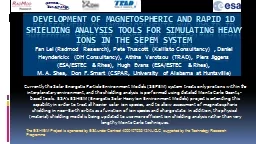PPT-Development of
Author : sherrill-nordquist | Published Date : 2016-07-05
Magnetospheric and Rapid 1D Shielding Analysis Tools for Simulating Heavy Ions in the SEPEM System Fan Lei Radmod Research Pete Truscott Kallisto Consultancy
Presentation Embed Code
Download Presentation
Download Presentation The PPT/PDF document "Development of" is the property of its rightful owner. Permission is granted to download and print the materials on this website for personal, non-commercial use only, and to display it on your personal computer provided you do not modify the materials and that you retain all copyright notices contained in the materials. By downloading content from our website, you accept the terms of this agreement.
Development of: Transcript
Download Rules Of Document
"Development of"The content belongs to its owner. You may download and print it for personal use, without modification, and keep all copyright notices. By downloading, you agree to these terms.
Related Documents














